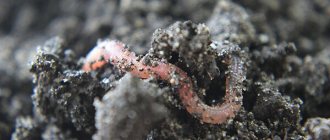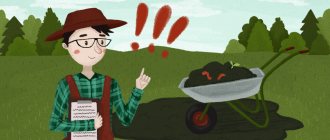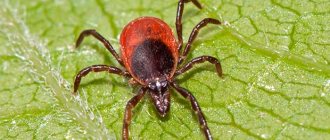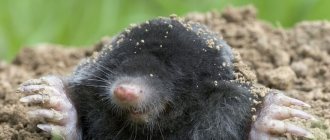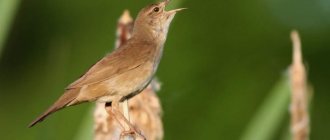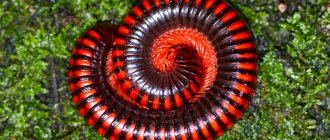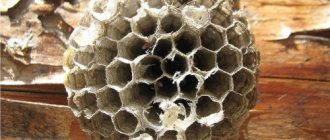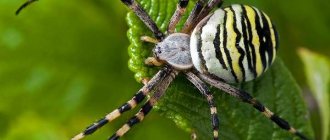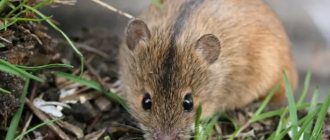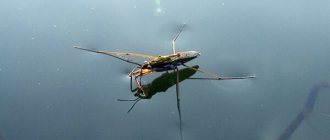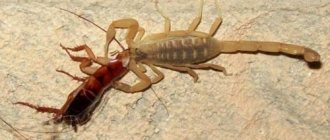Home — Zoology — Worms — Reproduction of earthworms
Well-known earthworms are not only one of the links in the food chain in nature. These are also mini-factories for processing organic residues that fall on the ground into a nutritious substance called humus. Thanks to them, the soil in which they live becomes richer and is able to breathe. The underground passages that the worm makes as it moves below the surface allow air to penetrate to the roots of the plants.
General characteristics
Earthworms are considered the most important soil helpers, for which there is still no replacement. The presence of colonies of the described eukaryotes in the soil has a positive effect on its fertility, which is due to an increase in the volume of organic matter.
Scientists have conducted many studies and have proven that the role of the earthworm for the ecosystem is incredibly large, and therefore it is difficult to overestimate it. The tiny inhabitant of the upper soil layers increases the level of humus and other nutrients, resulting in soil fertility. Unfortunately, many people do not even realize how important the activities of these creatures are for their existence . A decrease in the population of earthworms could lead to irreparable consequences, including a catastrophe in the form of famine and mass extinction of the planet's population.
The earthworm or earthworm has a segmented tubular body and is found wherever there are places with an abundant supply of moisture and organic matter. The maximum lifespan is 4−8 years and depends on the specific species. Sometimes the worm lives up to 10 years.
A distinctive feature of eukaryotes is the structure of the digestive system. As is known, in worms it runs along the entire length of the tubular body, and the processing of consumed organic substances is carried out by moving a set of muscles.
The common earthworm has a central and peripheral nervous system. In this case, breathing is carried out through the skin. The body consists of a mucous fluid that acts as a hydrostatic skeleton. The presence of cartilage or connective tissue is not required, since the functions of movement are performed by circular and longitudinal muscles.
The unique body structure makes the animal one of the most mysterious creatures on the globe. Worms do not have eyes, ears or lungs, but they do have several hearts. The unpleasant odor of the mucous fluid acts as a natural defense against predators, so the latter refuse to eat them.
Digestive system
Internal structure of an earthworm.
Digestive, nervous, circulatory system of an earthworm. The mouth is located at the anterior end of the earthworm's body; the anus is on the back.
The earthworm feeds on rotting plant debris, which it swallows along with the soil. It can also drag fallen leaves from the surface. Food is swallowed as a result of contraction of the muscles of the pharynx. The food then enters the intestines. Undigested remains, along with soil, are expelled through the anus at the rear end of the body.
The intestines are surrounded by a network of blood capillaries, which ensures the absorption of nutrients into the blood.
Types of earthworms
In nature, there are many families and subspecies of earthworms. According to the latest data, today there are more than 2 thousand species living on different continents and in different regions. 40 of them inhabit European countries. The most popular species include dung and ordinary earthworms. They look like this:
- If we talk about an ordinary earthworm, it can grow up to 30 centimeters in length and have a brown or red body. It is found on cultivated soil in gardens and orchards, fields and forests. Traces of the life activity of the species are represented by the formation of deep holes in the ground. Sometimes their depth reaches three meters. Earthworms live anywhere, provided there is good soil with rich organic matter and normal moisture levels.
- The size of the dung worm is much smaller. They range from 4 to 15 centimeters. The tubular body has a rusty color and unique yellow stripes around the rings. The name eukaryote explains its lifestyle: this worm prefers to live in areas with compost. In simple words - in manure. Normal functioning of the body is possible in the presence of organic material in the soil, as well as at a temperature range of 15 to 25 degrees Celsius.
Earthworms also have biological differences, namely the way they feed and the type of place they live. Through many studies, scientists were able to identify two key groups:
- Surface worms - found on the surface of the soil.
- Worms that make large holes in the ground and make homes there.
Reproduction
Earthworms are asexual hermaphrodites, capable of producing offspring within six months. They reproduce by cross-fertilization and find each other by smell on warm, humid evenings. In a wide belt on the body, fertilization and development of eggs occur, which are then laid in cocoons in the soil. Depending on weather conditions, up to 20 larvae hatch from the eggs within 1-5 months. And after another 3-4 months, the larvae become adults.
With good nutrition, earthworms reproduce very quickly. Over the course of a year, they can give birth to up to a thousand of their own kind.
Life cycle
The life of worms can be divided into four main stages . Among them:
- First stage. It consists of the emergence of tiny creatures from a small cocoon. The incubation period for the invertebrate eggs takes 2-8 weeks, after which the small creatures make their way to the surface. Their development can be very rapid, provided that the air temperature is consistently high. If the weather is warm and heavy with rainfall, then the eggs will fully mature in 14 days. However, in cold regions a similar process will last up to two months.
- Second phase. Involves the maturation of mature worms. From the first weeks of their existence, invertebrates actively develop, experiencing a number of changes in the reproductive system. At the age of one year, the worm can reproduce.
- Third stage. Describes the beginning of the fulfillment of a reproductive need. As is known, earthworms are hermaphrodites, having both female and male sexual characteristics. However, their mating occurs in a cooperative manner, when two individuals copulate and create a special shell. Sperm then accumulates in this membrane. Fertilization occurs in both bodies.
- At the fourth stage, animals carry out natural cocoon laying. After performing reproductive duties, the individuals separate, and a cocoon appears in each body, which soon rolls into the ground and matures. A standard cocoon contains from 1 to 5 embryos.
Nervous system
The nervous system of the earthworm (Fig. 52) is of the nodal type, consisting of a peripharyngeal nerve ring and an ventral nerve cord.
The ventral nerve cord contains giant nerve fibers that, in response to signals, cause the worm's muscles to contract. Such a nervous system ensures the coordinated work of the muscle layers associated with the digging, locomotor, feeding and sexual activity of the earthworm.
Unique properties and benefits for the garden
Earthworms provide enormous benefits to soil layers, enriching the soil with humus and other organic substances. Today, artificial breeding of these eukaryotes is even popularized to increase the fertility of vegetable gardens. Large populations of worms in the soil contribute to the productive cultivation of a wide variety of crops. In addition, animals are also useful for the gardening industry, since they have a positive effect on the development of fruit trees.
What are the benefits of worms for the soil? They are a natural soil loosener and improve its structure, which also increases the level of fertility. The activity of invertebrates deprives the gardener of a lot of additional work on processing the substrate.
As worms move around the garden, they dig deep and long holes, which promotes stable air exchange through the seeds and root systems of trees. Due to such work, tiny creatures are often called invisible plowmen. In addition, they perform excellent prevention of numerous diseases and provide protection against pests by eating rotted organic components, such as rotten leaves, grass clippings and dirt.
Through a well-developed digestive system, worms secrete a lot of organic matter, which consists of the following substances:
- Phosphorus.
- Nitrogen.
- Magnesium.
- Calcium.
Therefore, when identifying a colony of worms in your garden plot, you do not need to look for ways to combat them, but on the contrary, you should promote their further breeding.
You should pay attention to an interesting fact: The famous researcher Charles Darwin, who proposed the theory of natural selection, devoted a large amount of time to studying the life of worms. For about 40 years he conducted experiments and experiments, and then published a book called “The formation of the vegetable layer of the earth by the activity of earthworms and observations on their way of life.”
Scoops
The cutworm family includes more than a hundred species that damage beds.
The larvae of some species live underground and damage plant roots. The most common are winter cutworm, marsh cutworm, borer cutworm, and wild cutworm.
The larvae feed on the roots of tomatoes, beans, cabbage, wheat, rye, sunflower, beets, onions and garlic.
Prevention measures include installing pheromone traps and eliminating weeds near the beds. These measures reduce the number of adult butterflies, and, therefore, the number of larvae.
To combat the larvae, it is necessary to carry out deep digging of the soil and crop rotation. Karate, Fury or Decis are used as insecticides for spring spraying. In summer, Fufanon and Dursban are used. No more than two treatments are carried out per year. When planting potatoes, “Bazudin” is added to the holes.
Population increase
Currently, gardeners and people who practice organic farming practice many ways to improve soil fertility.
One of them is the reproduction of invertebrates. When performing this task, it is customary to add various organic matter to the soil, as well as mulch. The surface layers are treated with humus, fallen leaves, manure, compost and other similar substances. Some gardeners try to breed animals themselves. This action is not considered too difficult, so even beginners can do it. The main thing is to ensure optimal access to food , adequate humidity, protection from sunlight and plenty of free space. Successful breeding of a worm farm is possible in early spring or early summer, when the air temperature reaches optimal levels. During this period, the worms have time to mate and get stronger before the coming winter.
Weevils
Root
Root weevils feed mainly on strawberries and raspberries, significantly reducing the yields of these berries.
They have high fertility (up to 500 eggs). Larvae at any stage of development actively eat up the root system of plants.
In addition to the spring clutch, there is a summer clutch, the larvae from which go to winter.
The lifespan of adult insects is two to three years, and during this time they retain the ability to reproduce.
To destroy pests, spraying with karbofos or “Inta-vir” is carried out during the flowering of strawberries and raspberries.
Bark weevil
The bark beetle weevil is an active pest of fruit plants. Most often it is found on apple trees, quince, plums, cherry plums, apricots, and cherries.
Insects lay eggs directly in the rhizomes of plants, having previously made holes in them. Fertility up to 120 eggs per season. The hatched larvae first feed on the bark, then bite into trunks and branches. Most often, weevil colonies favor young gardens. Frail trees begin to hurt. Damaged branches dry out and break off.
To prevent beetle infestation, pruning and burning of dried branches is used. At the beginning of active flight of pests (approximately in the first ten days of May), trees are sprayed with Metaphos or Metathion. Chlorophos is not used against this pest due to its low effectiveness.
Arrangement of the worm house
If you want to start breeding earthworms at home, you need to equip a spacious worm barn in advance. The structure should become a comfortable home for the spineless, where they can live, eat and perform their biological duties.
A wooden box, a trough, an old bathtub and other similar structures can be used as a container. Experienced gardeners recommend placing high-quality open compost in the container. However, the ground must be protected with netting to prevent mass consumption of eukaryotes by birds and other natural enemies.
Proper worm care involves preparing suitable fertile soil. About 40 centimeters of compost should be placed at the bottom of the box, after which it should be filled with warm water. Next, you should create a straw bedding and wait a few days until the substances are completely absorbed. After completing these steps, you can put the worm into operation.
Finding the first group of worms to move is not difficult. It is enough to go to your own garden or vegetable garden and dig up a small layer of soil. Individuals living in the upper layers tolerate movement into the worm nest better than all others. Invertebrates are also sold in specialized gardening stores.
Settlement is carried out in several stages. The first thing a gardener needs to do is dig a small hole and then place a bucket of worms there. After this, the animals are covered with straw or burlap. In a week you will be able to notice the first results of the worms taking root.
To prevent the death of the colony, it is necessary to regularly monitor them. If the creatures demonstrate an active lifestyle, it means that they have managed to settle down normally , and everything is fine with them.
To improve adaptation to the new environment, the worms need to be fed only after 3-4 weeks. However, the heated liquid should be placed in the worm chamber at least twice a week.
Fertilization process
Let's take a closer look at the questions: how are earthworms born and how do they reproduce?
First of all, you need to know that earthworms are hermaphrodites, they have both sperm and egg maturation.
When a worm has the above-mentioned belt, this means that it can already reproduce. In this way, fully formed earthworms are identified. You can observe how they reproduce by finding a pair of them stuck together on the ground.
The fact is that at the time of puberty the animal has all male characteristics. And first, two individuals come together and touch with the ends closest to the head, and their bodies are literally glued together with the help of a sticky liquid released. At this time, the belts of worms are located opposite each other, and seminal fluid is exchanged, after which the partners crawl apart.
The next stage of reproduction begins, which all earthworms go through. How do they reproduce if at first there are only males in front of us? It turns out that after the exchange of sperm, the individual also exhibits female characteristics: the ovaries mature and eggs appear. The coupling begins to move towards the head end of the body. The first to enter it are your own eggs. As the coupling continues to move at the level of the 10th segment, the seminal fluid fertilizes the egg. At the last stage of reproduction, the muff falls off the worm's body through the head end and forms a cocoon that looks like a lemon.
There is no larval stage in earthworms. The cocoon shell protects the embryos from harmful microorganisms, while allowing water and salts to pass through well, which are necessary for the life of the future offspring. When fully matured, the activity of the cubs increases, and they emerge from the cocoon on their own. After a short period of time, small worms become full-fledged adult earthworms.
Subtleties of proper care
To extend the lifespan of earthworms, they need to be properly cared for, providing comfortable conditions for development and reproductive functions. The key rules of care are to ensure a comfortable temperature, shade and stable access to food.
Professional gardeners recommend enriching compost manure with sand or crushed eggshells. Dry food is added to the soil approximately once every two weeks, but it is important to take precautions here so as not to overfeed the worms.
If you want to start breeding creatures at home, you need to remember that worms process almost everything that catches their eye. The main thing is that the products are small in size, because invertebrates do not have teeth.
Before replenishing the worm house with new food, you need to make sure that the previous organic matter is completely destroyed. If this is not the case, the animals will suffer from oversaturation and die. Leaving organic compounds in the compost will negatively impact the acidity levels, leading to deadly conditions. In addition, excess food supply contributes to the development of pests such as mites.
Caring for worms is relatively easy, but some requirements must be met. Only under such conditions will breeding a home farm bring the expected success.
Adviсe
- Worms should be protected from direct sunlight. If you notice that the worms tend to crawl away, congregating at the edge of the container, it is necessary to place a source of artificial light above the surface of the container to prevent the worms from spreading.
- If you are able to breed more worms than you need, then you can sell them to a fishing bait shop, or give them to other fishermen.
- When you are going fishing, take with you exactly as many worms as you consider necessary for that day. You can place animals in special containers that are made for this purpose and have porous sides, or use cardboard ice cream boxes filled with peat moss and have holes to allow air to enter.
Offspring
So, in the case described, an earthworm is present and how it reproduces, based on this, it is not difficult to understand. The cocoon laid by an earthworm contains from two to twenty eggs. They develop in about 20 days, after which tiny, thread-thin babies are born. Their length does not exceed 6 mm. But they grow quickly and after 12 weeks they become sexually mature and are able to continue the breeding cycle.
By the way, worms live up to 15 years and can grow several tens of centimeters in length.
